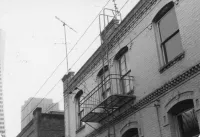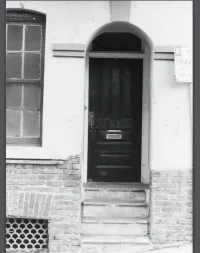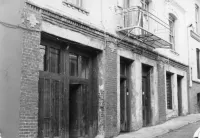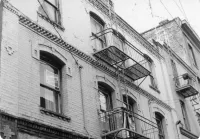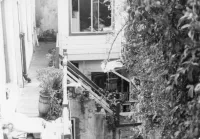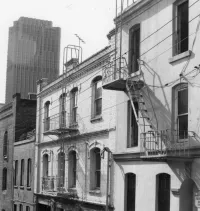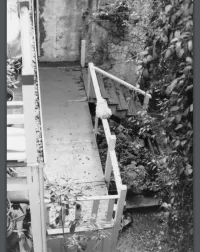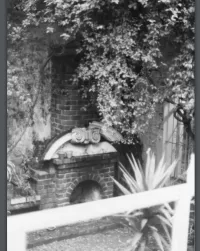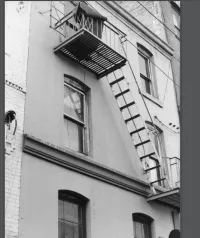Share what you know,
and discover more.
Share what you know,
and discover more.
May 31, 1979
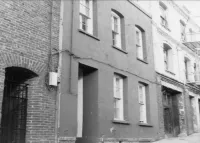
-

- Charmaine Bantugan
Old Ohio Street Houses - National Register of Historic Places
Statement of Significance: These three buildings are contiguous to the Jackson Square Historic Distinct, the except for one earlier building, are of the same age as adjacent buildings - post 1906 Earthquake and Fire. Aesthetically the buildings are of the same tone as the Distinct- they differ, however, in historic use, for the buildings were built and used as residential units, not as stories with “lodging” above. As a result, the buildings give an added historical and social commission to the district” small flats, occupied by persons who worked in the area, a situated, size and type of lodging typical at the lower working classes in San Francisco until roughly the turn of the century. Sometime after 1899 and before 1905 a new brick building was built at 17 Osgood. The Assessor's office estimated it as 1900. This building was damaged in the Earthquake and Fire of 1906, but was rebuilt using the existing brick walls, and extended to cover almost the entire lot. Owners in 1906 were Louis and Giovanni F. Arata. The two frame buildings at 25-47 Osgood were replaced after the Fire by a double building with a common facade and common center wall. The southerly half of the building, occupied by the Figone family had a stable on the first floor for four horses and a cow. The buildings were finished in 1907 and water was connected in the name of Figone and S. Cortazi (sic). The third building, at 55 Osgood, was designed by architects Perseo Righetti and Henry Kuhl, offices in the Humboldt Bank building, and was finished by November of 1906. The owner was P. Borrozzi (sic). New frame buildings were built at the rear of all buildings except 17 Osgood. These were very small structures, each with two flats of two rooms each, and brick walls along the property lines. The Figone family returned to Osgood after the Fire (John Figone with A. Paladini, wholesale fish, was at 41 Osgood; Louis Figone, laborer, was at 43 Osgood), but the other lot owners appear to have moved elsewhere. After the fire, the Barbary Coast reclaimed at least some of its old reputation. In 1911 on the south side of Pacific between Montgomery and Sansome Streets there were, from west to east: a dance hall, saloon, saloon, saloon, "Temporary Mission," vacant lot, saloon, "vacant saloon and Cheap Show," San Francisco Fire Department Engine #1, vacant lot, saloon, storage, saloon, and a cigar factory. Colliers Magazine described the area in a 1912 article written by Allice Cowdrey entitled, "On the Barbary Coast -- A Woman's Visit to the San Francisco Quarter Where the 'Turkey Trot' originated:" out on the muddy cobbles again, to the depths of Barbary Coast. Here, too the narrow street is filled with men... Names of the dance halls, exotic or patriotic -- 'The Lotus,' 'Our Navy' -- in screaming electrics, make the streets a blaze of life; but, nevertheless, there is an air of secrecy in the very air that yields to no blazing light. "We go downstairs... in a large circle, couples are dancing. There are sailors and many more men that I cannot assign to any place but here...There are girls fearfully and unbelievably coated with paint...Some of the couples are snapping out and clinging in the 'Texas Tommy.' "Nobody seems to talk. Nobody seems to smile, and drink and rag and drink again." Colliers. May 4, 1912 Survey Magazine for September 4, 1915, noted that: "Within two blocks on either side of police headquarters and patrolled by policemen in uniform there has existed for years a group of over 100 houses of prostitution...Adjoining these open houses of prostitution, known as 'The District,' is the 'Barbary Coast' dance hall quarter, its worst conditions being found on Pacific Street, or 'Terrific Street,' as it is familiarly called." In February of 1917, when the Red-Light Abatement Act >s finally enforced, the police department "dramatically closed more than 200 houses" of prostitution. (Survey Magazine, March 17, 1917). The effect of Prohibition followed within a couple of years, and the saloons became establishments offering "refreshments" and "soft drinks.' But neighborhood respectability did not follow. The San Francisco Examiner for November 19, 1921, reported: "The proprietor of the Thalia, the: post pretentious dance hall on Pacific Street, was found guilty. yesterday of conducting a disorderly house...This court ruling, the first genuine official ruling that has ever been aimed at the Barbary Coast region, is regarded as a staggering blow to resort owners on Pacific Street...During the past two weeks, more than 300 arrests have been made in Pacific Street resorts by police... More than 200 of this number were women habitues who were charged either with vagrancy or with being inmates of a disorderly house." Local conjecture has it that these buildings on Osgood housed a brothel. There is no way to substantiate or refute this, but it is more likely that the small flats provided housing for lower income people. The original Italian families had moved out by about 1915, although they continued to own the buildings. In 1922, 47 Osgood was sold by the estate of Samuel and Domenica Cortopassi to John Delucchi. P. Anastasia Barozzi sold his property in 1925, and the properties of the estates of Luigi Arata and Luigi Figone were sold in 1937 and 1938. An owner of all the Osgood lots at various times in the 1930's was Marston Campbell, Jr., manager of a cosmetics firm. Campbell lived at 55 Osgood until World War II. An architect occupied 17 Osgood for some time during the war years. The World's Fair of 1939 brought a revival of business to the area as new taverns and dance halls were opened to cater to tourists. The area continued as an entertainment enclave, known as the "International Settlement," into the 1950's. Again, Pacific Street was the main street in the district. The buildings on Osgood were used during the 1950's and 1960's by artists, writers and musicians. It is reputed that Lenny Bruce and Ralph Ginzberg lived there in the mid-1950's. More recently "underground" movies have been filmed there. In the 1960's architects and decorators moved into the Jackson Square area, reclaiming the old buildings and showrooms, and preserving the small scale and harmonious proportions of the buildings, and their relationship to the streets and alleys. The Osgood Place buildings face on one such alley and immediately about the Jackson Square Historical District.
Old Ohio Street Houses - National Register of Historic Places
Statement of Significance: These three buildings are contiguous to the Jackson Square Historic Distinct, the except for one earlier building, are of the same age as adjacent buildings - post 1906 Earthquake and Fire. Aesthetically the buildings are of the same tone as the Distinct- they differ, however, in historic use, for the buildings were built and used as residential units, not as stories with “lodging” above. As a result, the buildings give an added historical and social commission to the district” small flats, occupied by persons who worked in the area, a situated, size and type of lodging typical at the lower working classes in San Francisco until roughly the turn of the century. Sometime after 1899 and before 1905 a new brick building was built at 17 Osgood. The Assessor's office estimated it as 1900. This building was damaged in the Earthquake and Fire of 1906, but was rebuilt using the existing brick walls, and extended to cover almost the entire lot. Owners in 1906 were Louis and Giovanni F. Arata. The two frame buildings at 25-47 Osgood were replaced after the Fire by a double building with a common facade and common center wall. The southerly half of the building, occupied by the Figone family had a stable on the first floor for four horses and a cow. The buildings were finished in 1907 and water was connected in the name of Figone and S. Cortazi (sic). The third building, at 55 Osgood, was designed by architects Perseo Righetti and Henry Kuhl, offices in the Humboldt Bank building, and was finished by November of 1906. The owner was P. Borrozzi (sic). New frame buildings were built at the rear of all buildings except 17 Osgood. These were very small structures, each with two flats of two rooms each, and brick walls along the property lines. The Figone family returned to Osgood after the Fire (John Figone with A. Paladini, wholesale fish, was at 41 Osgood; Louis Figone, laborer, was at 43 Osgood), but the other lot owners appear to have moved elsewhere. After the fire, the Barbary Coast reclaimed at least some of its old reputation. In 1911 on the south side of Pacific between Montgomery and Sansome Streets there were, from west to east: a dance hall, saloon, saloon, saloon, "Temporary Mission," vacant lot, saloon, "vacant saloon and Cheap Show," San Francisco Fire Department Engine #1, vacant lot, saloon, storage, saloon, and a cigar factory. Colliers Magazine described the area in a 1912 article written by Allice Cowdrey entitled, "On the Barbary Coast -- A Woman's Visit to the San Francisco Quarter Where the 'Turkey Trot' originated:" out on the muddy cobbles again, to the depths of Barbary Coast. Here, too the narrow street is filled with men... Names of the dance halls, exotic or patriotic -- 'The Lotus,' 'Our Navy' -- in screaming electrics, make the streets a blaze of life; but, nevertheless, there is an air of secrecy in the very air that yields to no blazing light. "We go downstairs... in a large circle, couples are dancing. There are sailors and many more men that I cannot assign to any place but here...There are girls fearfully and unbelievably coated with paint...Some of the couples are snapping out and clinging in the 'Texas Tommy.' "Nobody seems to talk. Nobody seems to smile, and drink and rag and drink again." Colliers. May 4, 1912 Survey Magazine for September 4, 1915, noted that: "Within two blocks on either side of police headquarters and patrolled by policemen in uniform there has existed for years a group of over 100 houses of prostitution...Adjoining these open houses of prostitution, known as 'The District,' is the 'Barbary Coast' dance hall quarter, its worst conditions being found on Pacific Street, or 'Terrific Street,' as it is familiarly called." In February of 1917, when the Red-Light Abatement Act >s finally enforced, the police department "dramatically closed more than 200 houses" of prostitution. (Survey Magazine, March 17, 1917). The effect of Prohibition followed within a couple of years, and the saloons became establishments offering "refreshments" and "soft drinks.' But neighborhood respectability did not follow. The San Francisco Examiner for November 19, 1921, reported: "The proprietor of the Thalia, the: post pretentious dance hall on Pacific Street, was found guilty. yesterday of conducting a disorderly house...This court ruling, the first genuine official ruling that has ever been aimed at the Barbary Coast region, is regarded as a staggering blow to resort owners on Pacific Street...During the past two weeks, more than 300 arrests have been made in Pacific Street resorts by police... More than 200 of this number were women habitues who were charged either with vagrancy or with being inmates of a disorderly house." Local conjecture has it that these buildings on Osgood housed a brothel. There is no way to substantiate or refute this, but it is more likely that the small flats provided housing for lower income people. The original Italian families had moved out by about 1915, although they continued to own the buildings. In 1922, 47 Osgood was sold by the estate of Samuel and Domenica Cortopassi to John Delucchi. P. Anastasia Barozzi sold his property in 1925, and the properties of the estates of Luigi Arata and Luigi Figone were sold in 1937 and 1938. An owner of all the Osgood lots at various times in the 1930's was Marston Campbell, Jr., manager of a cosmetics firm. Campbell lived at 55 Osgood until World War II. An architect occupied 17 Osgood for some time during the war years. The World's Fair of 1939 brought a revival of business to the area as new taverns and dance halls were opened to cater to tourists. The area continued as an entertainment enclave, known as the "International Settlement," into the 1950's. Again, Pacific Street was the main street in the district. The buildings on Osgood were used during the 1950's and 1960's by artists, writers and musicians. It is reputed that Lenny Bruce and Ralph Ginzberg lived there in the mid-1950's. More recently "underground" movies have been filmed there. In the 1960's architects and decorators moved into the Jackson Square area, reclaiming the old buildings and showrooms, and preserving the small scale and harmonious proportions of the buildings, and their relationship to the streets and alleys. The Osgood Place buildings face on one such alley and immediately about the Jackson Square Historical District.
May 31, 1979
Old Ohio Street Houses - National Register of Historic Places
Statement of Significance:These three buildings are contiguous to the Jackson Square Historic Distinct, the except for one earlier building, are of the same age as adjacent buildings - post 1906 Earthquake and Fire. Aesthetically the buildings are of the same tone as the Distinct- they differ, however, in historic use, for the buildings were built and used as residential units, not as stories with “lodging” above. As a result, the buildings give an added historical and social commission to the district” small flats, occupied by persons who worked in the area, a situated, size and type of lodging typical at the lower working classes in San Francisco until roughly the turn of the century.
Sometime after 1899 and before 1905 a new brick building was built at 17 Osgood. The Assessor's office estimated it as 1900. This building was damaged in the Earthquake and Fire of 1906, but was rebuilt using the existing brick walls, and extended to cover almost the entire lot. Owners in 1906 were Louis and Giovanni F. Arata.
The two frame buildings at 25-47 Osgood were replaced after the Fire by a double building with a common facade and common center wall. The southerly half of the building, occupied by the Figone family had a stable on the first floor for four horses and a cow. The buildings were finished in 1907 and water was connected in the name of Figone and S. Cortazi (sic).
The third building, at 55 Osgood, was designed by architects Perseo Righetti and Henry Kuhl, offices in the Humboldt Bank building, and was finished by November of 1906. The owner was P. Borrozzi (sic).
New frame buildings were built at the rear of all buildings except 17 Osgood. These were very small structures, each with two flats of two rooms each, and brick walls along the property lines.
The Figone family returned to Osgood after the Fire (John Figone with A. Paladini, wholesale fish, was at 41 Osgood; Louis Figone, laborer, was at 43 Osgood), but the other lot owners appear to have moved elsewhere.
After the fire, the Barbary Coast reclaimed at least some of its old reputation. In 1911 on the south side of Pacific between Montgomery and Sansome Streets there were, from west to east: a dance hall, saloon, saloon, saloon, "Temporary Mission," vacant lot, saloon, "vacant saloon and Cheap Show," San Francisco Fire Department Engine #1, vacant lot, saloon, storage, saloon, and a cigar factory.
Colliers Magazine described the area in a 1912 article written by Allice Cowdrey entitled, "On the Barbary Coast -- A Woman's Visit to the San Francisco Quarter Where the 'Turkey Trot' originated:" out on the muddy cobbles again, to the depths of Barbary Coast. Here, too the narrow street is filled with men... Names of the dance halls, exotic or patriotic -- 'The Lotus,' 'Our Navy' -- in screaming electrics, make the streets a blaze of life; but, nevertheless, there is an air of secrecy in the very air that yields to no blazing light.
"We go downstairs... in a large circle, couples are dancing. There are sailors and many more men that I cannot assign to any place but here...There are girls fearfully and unbelievably coated with paint...Some of the couples are snapping out and clinging in the 'Texas Tommy.'
"Nobody seems to talk. Nobody seems to smile, and drink and rag and drink again."
Colliers. May 4, 1912
Survey Magazine for September 4, 1915, noted that:
"Within two blocks on either side of police headquarters and patrolled by policemen in uniform there has existed for years a group of over 100 houses of prostitution...Adjoining these open houses of prostitution, known as 'The District,' is the 'Barbary Coast' dance hall quarter, its worst conditions being found on Pacific Street, or 'Terrific Street,' as it is familiarly called."
In February of 1917, when the Red-Light Abatement Act >s finally enforced, the police department "dramatically closed more than 200 houses" of prostitution. (Survey Magazine, March 17, 1917).
The effect of Prohibition followed within a couple of years, and the saloons became establishments offering "refreshments" and "soft drinks.' But neighborhood respectability did not follow. The San Francisco Examiner for November 19, 1921, reported:
"The proprietor of the Thalia, the: post pretentious dance hall on Pacific Street, was found guilty. yesterday of conducting a disorderly house...This court ruling, the first genuine official ruling that has ever been aimed at the Barbary Coast region, is regarded as a staggering blow to resort owners on Pacific Street...During the past two weeks, more than 300 arrests have been made in Pacific Street resorts by police... More than 200 of this number were women habitues who were charged either with vagrancy or with being inmates of a disorderly house."
Local conjecture has it that these buildings on Osgood housed a brothel. There is no way to substantiate or refute this, but it is more likely that the small flats provided housing for lower income people. The original Italian families had moved out by about 1915, although they continued to own the buildings.
In 1922, 47 Osgood was sold by the estate of Samuel and Domenica Cortopassi to John Delucchi. P. Anastasia Barozzi sold his property in 1925, and the properties of the estates of Luigi Arata and Luigi Figone were sold in 1937 and 1938. An owner of all the Osgood lots at various times in the 1930's was Marston Campbell, Jr., manager of a cosmetics firm. Campbell lived at 55 Osgood until World War II. An architect occupied 17 Osgood for some time during the war years.
The World's Fair of 1939 brought a revival of business to the area as new taverns and dance halls were opened to cater to tourists. The area continued as an entertainment enclave, known as the "International Settlement," into the 1950's. Again, Pacific Street was the main street in the district. The buildings on Osgood were used during the 1950's and 1960's by artists, writers and musicians. It is reputed that Lenny Bruce and Ralph Ginzberg lived there in the mid-1950's. More recently "underground" movies have been filmed there.
In the 1960's architects and decorators moved into the Jackson Square area, reclaiming the old buildings and showrooms, and preserving the small scale and harmonious proportions of the buildings, and their relationship to the streets and alleys. The Osgood Place buildings face on one such alley and immediately about the Jackson Square Historical District.
Posted Date
Apr 11, 2022
Historical Record Date
May 31, 1979
Source Name
United States Department of Interior - National Park Service
Source Website
Delete Story
Are you sure you want to delete this story?


